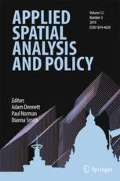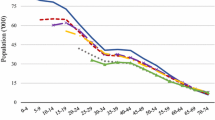Abstract
In this paper, a model is developed to project interregional migration flows for the Aboriginal and Torres Strait Islander (Indigenous) populations in Australia at the state and territory level by age and sex. Migration flow data, obtained from the three most recent Australian quinary censuses (2001, 2006 and 2011), are first assessed and analysed in comparison with the patterns of the corresponding non-Indigenous population. Log-linear models are used to identify the key structures and patterns over time. A model is then developed to project the migration flows by origin, destination, age and sex forward in 5-year increments to 2031. This includes incorporating techniques to overcome the small number cell issues associated with the very small population size of the Indigenous population. The results of this research provide (i) insights into the different migration patterns of an important but disadvantaged minority population in Australia and (ii) inputs for a dynamic multiregional model of Indigenous population change.








Similar content being viewed by others
Notes
Source: Australian Bureau of Statistics (2003, p. 57)
References
Agresti, A. (2013). Categorical data analysis (3rd ed.). Hoboken: Wiley.
Australian Bureau of Statistics. (2003). Census of population and housing: Population growth and distribution, Australia, 2001. Canberra: Australian Bureau of Statistics.
Australian Bureau of Statistics (2013). Census of population and housing: Understanding the increase in Aboriginal and Torres Strait Islander counts, 2006–2011. Cat. No. 2077.0, Australian Bureau of Statistics, Canberra. Available at http://www.abs.gov.au/ausstats/abs@.nsf/Lookup/2077.0Technical+Note12006-2011.
Australian Bureau of Statistics. (2014). Estimates and projections, Aboriginal and Torres Strait Islander Australians: 2001–2026. Cat. No. 3238.0. Canberra: Australian Bureau of Statistics.
Biddle, N. (2012). Population and age structure. Paper 5, CAEPR Indigenous Population Project 2011 Census Papers, Centre for Aboriginal and Economic Policy Research. Canberra: The Australian National University.
Biddle, N. (2013). Population projections. Paper 14, CAEPR Indigenous Population Project 2011 Census Papers, Centre for Aboriginal Economic Policy Research. Canberra: The Australian National University.
Biddle, N., & Hunter, B. (2006). An analysis of the internal migration of indigenous and non-indigenous Australians. Australian Journal of Labour Economics, 9(4), 321–341.
Biddle, N., & Prout, S. (2009). The geography and demography of Indigenous temporary mobility: an analysis of the 2006 Census snapshot. Journal of Population Research, 26(4), 305–326.
Biddle, N., & Yap, M. (2010). Demographic and socioeconomic outcomes across the indigenous Australian lifecourse: Evidence from the 2006 Census. Research monograph no. 31, Centre for Aboriginal Economic Policy Research. Canberra: ANU E Press, The Australian National University.
Bijak, J. (2010). Forecasting international migration in Europe: A Bayesian view. Dordrecht: Springer.
Morphy, F. (2007). Agency, contingency and census process: Observations of the 2006 Indigenous Enumeration Strategy in remote Aboriginal Australia. Research Monograph No. 28, Centre for Aboriginal Economic Policy Research. Canberra: ANU E Press, The Australian National University.
Raymer, J. (2010). A general framework for estimating population movements. In: T. Salzmann, B. Edmonston & J. Raymer (eds.), Demographic aspects of migration (pp. 73–96).
Raymer, J., & Rogers, A. (2007). Using age and spatial flow structures in the indirect estimation of migration streams. Demography, 44(2), 199–223.
Raymer, J., Bonaguidi, A., & Valentini, A. (2006). Describing and projecting the age and spatial structures of interregional migration in Italy. Population, Space and Place, 12(5), 371–388.
Raymer, J., Smith, P. W. F., & Giulietti, C. (2011). Combining census and registration data to analyse ethnic migration patterns in England from 1991 to 2007. Population, Space and Place, 17(1), 73–88.
Rogers, A. (1990). Requiem for the net migrant. Geographical Analysis, 22, 283–300.
Rogers, A. (1995). Multiregional demography: Principles, methods and extensions. Chichester: Wiley.
Rogers, A., Willekens, F. J., Little, J. S., & Raymer, J. (2002). Describing migration spatial structure. Papers in Regional Science, 81, 29–48.
Rogers, A., Willekens, F. J., & Raymer, J. (2003). Imposing age and spatial structures on inadequate migration-flow datasets. The Professional Geographer, 55(1), 56–69.
Smith, P. W. F., Raymer, J., & Giulietti, C. (2010). Combining available migration data in England to study economic activity flows over time. Journal of the Royal Statistical Society: Series A (Statistics in Society), 173(4), 733–753.
Snickars, F., & Weibull, J. W. (1977). A minimum information principle: theory and practice. Regional Science and Urban Economics, 7(1–2), 137–168.
Taylor, J. (1997). The contemporary demography of Indigenous Australians. Journal of the Australian Population Association, 14(1), 77–114.
Taylor, J. (2003). Indigenous Australians: The first transformation. In S.-E. Khoo & P. McDonald (Eds.), The transformation of Australia’s population: 1970–2030 (pp. 17–39). Sydney: University of New South Wales Press.
Van Wissen, L., Van der Gaag, N., Rees, P., & Stillwell, J. (2008). In search of a modelling strategy for projecting internal migration in European countries. In J. Poot, B. Waldorf, & L. Van Wissen (Eds.), Migration and human capital (pp. 49–74). Cheltenham: Edward Elgar.
Willekens, F. (1983). Log-linear modelling of spatial interaction. Papers of the Regional Science Association, 52, 187–205.
Willekens, F. (1994). Monitoring international migration flows in Europe: towards a statistical data base combining data from different sources. European Journal of Population, 10, 1–42.
Author information
Authors and Affiliations
Corresponding author
Additional information
Paper prepared for the 2015 Annual Meeting of the Population Association of America, San Diego. Research funded by the Australian Research Council as part of the Linkage Project on ‘Improved Indigenous Population Projections for Policy and Planning’ (LP130100735).
Rights and permissions
About this article
Cite this article
Raymer, J., Biddle, N. & Campbell, P. Analysing and Projecting Indigenous Migration in Australia. Appl. Spatial Analysis 10, 211–232 (2017). https://doi.org/10.1007/s12061-015-9179-6
Received:
Accepted:
Published:
Issue Date:
DOI: https://doi.org/10.1007/s12061-015-9179-6




